We bake the vast majority of all the bread products we consume here, and especially love to make our own sourdough. To maintain a healthy sourdough starter, it requires the barm is ‘fed’ regularly with fresh flour, and water, to keep the yeast culture active and lively. To keep our starter ready to bake with, we generally feed it at least once per week.
Occasionally though we find ourselves with extra barm, and do sometimes find ourselves having to discard the excess. With an almost 30% increase in flour prices over the last 12 months though, it really pains me to throw any away, so I’m always on the lookout for new recipes to help put the extra barm to good use.
If you’re maintaining your own sourdough starter you likely already have an arsenal of recipes for various incarnations of sourdough muffins, pancakes, waffles, pizza doughs, and quick breads lurking in your kitchen.
Eager to try something different, I recently stumbled across a recipe for a sourdough chocolate cake. Sourdough, with chocolate? I was intrigued. However, some of the reviews seemed to fall a little flat, and honestly, the overall appearance of the cake was a little more plain than I’d like, and not quite something I’d choose to serve to guests.
I was curious to try this cake though, and after reading the criticisms of this recipe, I decided to start by making a few changes.
The first ingredient to go was the vegetable oil. I’m not a fan of vegetable oil in cakes. Cakes, in my personal opinion, really deserve pure unadulterated butter. However, substituting butter for oil isn’t necessarily straightforward, especially when baking, as at room temperature oil is a liquid, and butter is a solid. The total fat and water contents of oil versus butter aren’t equivalent either.
The recipe also only called for cocoa powder, with no actual chocolate solids, which of course leaves the artery-hardening moisture-enhancing cocoa butter component out completely. Where’s the fun in that? My personal philosophy is that if you’re going to indulge, you might as well go the whole hog. As some of my favorite chocolate recipes utilize both cocoa and chocolate, I hoped that adding a touch of real chocolate, along with substituting the butter, not only might help to balance the ratio of fat in this recipe, but should also contribute to a deeper overall chocolate flavor. There’s certainly no harm in trying.
I was a little concerned the cake could be dry with butter, and some suggested the cake was too dense, so I also increased the egg content.
The flat sheet-pan look had to go too. Hence, a slight makeover with the help of a bundt pan to give the cake a more appealing shape, which of course does require a little more time to bake, but would hopefully make the cake more presentable.
So, intrigued enough to try turning some of our sourdough barm into some form of this chocolate cake, I began my little experiment in the kitchen, realizing it could go horribly awry. Fortunately, before I embarked on my quest, Mr. Curbstone gleefully volunteered to consume any evidence of kitchen-borne errors that day.
What emerged from the oven though was a beautiful, aromatic, lush, rich, chocolatey indulgence worthy of any festive occasion, and elegant enough to serve for company. The texture is moist, but light, definitely not heavy, and the flavor is undeniably chocolate. So, by request, and just in time for New Year’s Eve, here’s our Double-Chocolate Sourdough Bundt cake. If you don’t have a sourdough starter, I strongly recommend seeing if you can beg, borrow, or barter a cup from a friend, or neighbor.
Yield: 16 Slices
Bundt Cake:
1 Cup Active Sourdough Starter
1-1/4 cup Whole milk*
2 cups Unbleached All-Purpose Flour
16 Tbsp (8 oz) Butter
4 oz Bittersweet Chocolate (72%)
3 Large Eggs
1-1/2 Cups Granulated Sugar (fine grain Baker’s Sugar preferred)
3/4 cup Unsweetened Baking Cocoa (NOT DUTCH PROCESSED)**
1 Tsp Table Salt
1-1/2 Tsp Baking Soda
1 Tsp Pure Vanilla Extract
1 Tsp Pure Almond Extract
Chocolate Ganache (optional):
6 Tbsp Heavy Cream
2 oz. Bittersweet Chocolate
Preheat Oven to 350F
Equipment:
12-Cup Bundt cake pan
Stand mixer with whisk, and paddle attachments
Prepare the Cake Batter
One to two hours before you plan to make the cake, combine the sourdough starter, milk*, and flour in a large mixing bowl. Mix until the flour is hydrated, and cover with plastic wrap, or a damp kitchen towel. Allow this mixture to rest at room temperature for 1-2 hours. The dough should relax, and expand somewhat during this time, but won’t become as bubbly as your starter may appear normally.
Butter, and lightly flour a 12-Cup Bundt cake pan.
When ready to make the cake, melt the butter and chocolate together over medium-low heat, stirring frequently until the chocolate has completely melted. Set the pan aside to cool for a few minutes.
In the bowl of a mixer, fitted with the whisk attachment, beat the eggs and sugar together until thickened, and pale yellow in color.
Change to the paddle attachment. In a small bowl mix together the cocoa, salt, and baking soda, and add to the egg mixture at lowest speed.
On medium speed, add the melted butter and chocolate mixture by slowly pouring it down the inside of the bowl so as not to shock the eggs. Then mix in the vanilla and almond extracts.
Add one half of the sourdough/milk/flour mixture to the bowl. Mix on medium speed until evenly incorporated, then add the remaining sourdough mixture, and combine thoroughly. There should be no remaining streaks of sourdough visible.
Pour into a prepared bundt pan, and rap the cake pan on the counter to force out any air bubbles. Level the top with the back of a spoon or spatula, and bake in the center of the oven for 50-60 minutes, or until a toothpick inserted in the center comes out clean.
Allow the cake to cool in the pan for 10-15 minutes before inverting onto a cooling rack, then allow the cake to cool completely.
Prepare the Ganache
To make the ganache, place the chocolate in a heat resistant bowl.
Put the heavy cream in a small saucepan over medium heat, just until the cream begins to boil, and pour the hot cream over the chocolate.
Allow the chocolate and cream to stand for 3-4 minutes, and then mix with a spatula until thoroughly incorporated.
Place the ganache in a small zip-top bag, and snip a very tiny piece from the corner, and drizzle the ganache evenly over the shoulders of the cake, letting it run over the sides. Allow the ganache to set before serving.
This cake is moist enough to be served alone, and was excellent with a little sweetened fresh cream.
If I’m honest, perhaps the only other thing that may have really put this cake over the top, indulgence-wise, may have been a generous drizzle of a fresh raspberry coulis. Sadly, we’ve run out of cake, so clearly we’ll have to bake this again during raspberry season. Oh. Darn.
We have to admit though, as much as we love our sourdough bread, we’ve never seen sourdough look, or taste, quite this good in the Curbstone Valley kitchen. Enjoy!
————————
* Note, I maintain a relatively firm sourdough barm mixture. If your barm is somewhat loose, more akin to the texture of a thick pancake-batter, start by only adding one cup of milk. You can add more, up to 1/4 cup of milk, if needed to hydrate the flour.
** Remember, baking is not only art, it’s SCIENCE too! Dutch Processed cocoa powder, and unsweetened baking cocoa are NOT freely interchangeable in most recipes. Sourdough barm is acidic (has a low pH), as is the unsweetened cocoa, and they will interact with the alkaline baking soda in this recipe to help give this cake some lift. Dutch Processed cocoa powder has been treated with alkali, which makes it less acidic (higher in pH) than conventional baking cocoa. As such Dutch Processed cocoa will raise the pH and NOT react satisfactorily with the baking soda, and alter the texture of the cake.
To avoid disappointment, only use pure unsweetened baking cocoa in this recipe…the good stuff, of course!

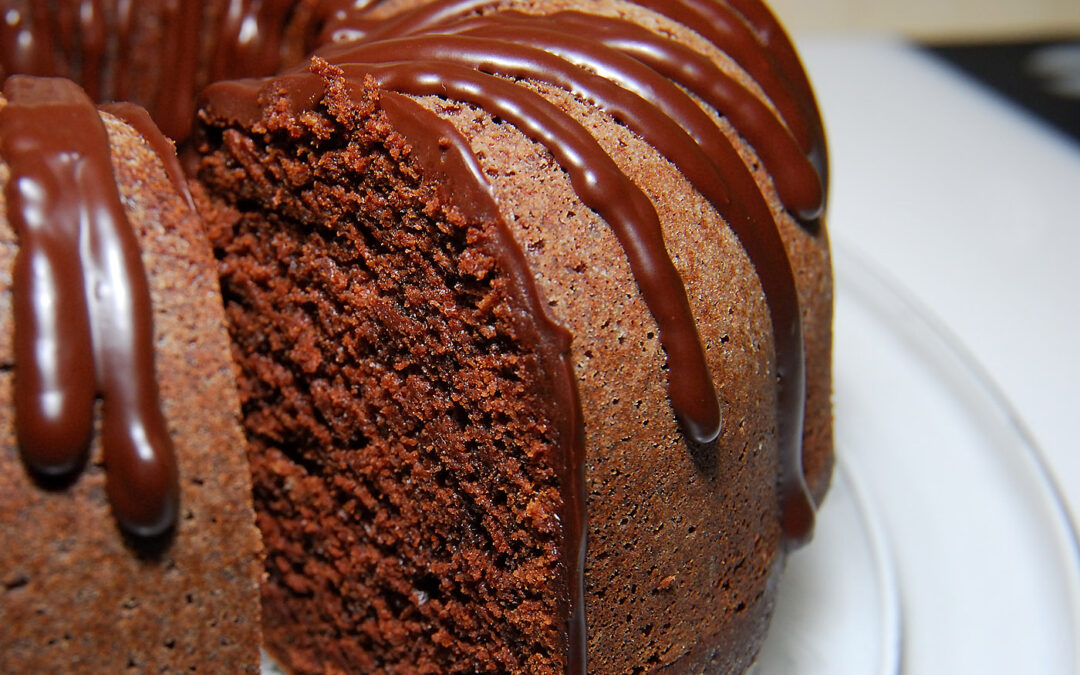
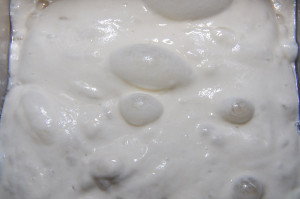

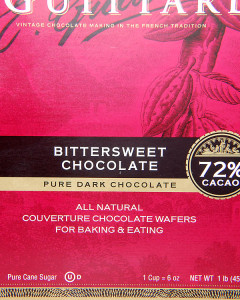

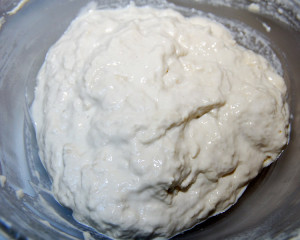
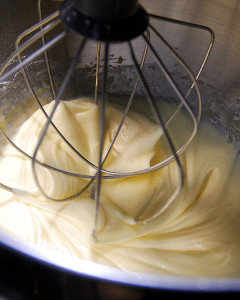
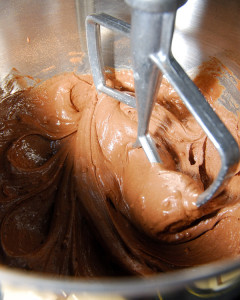





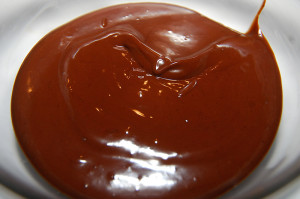



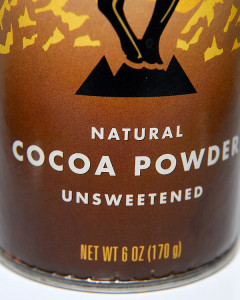







My that looks sooo good…Love good chocolate and with sourdough…mmmmm
It really WAS good 😉 Of course, everything in moderation, so it may be a little while before I make this again, but I’m definitely trying it raspberries next time!
Oooh, you had me with the title alone! I will add this one to my recipe folder to make soon. Not soon enough though. Mrs. HA is on a no-chocolate regimen at the moment and I am not going to be cruel and make things she can’t eat. I reserve the right to look at your photos and drool though! 😀
Ack! No chocolate? I so admire her for trying. I’m not a huge chocolate fan, and tend to pick fruit desserts over chocolate ones. However, when I do eat it, I tend to prefer dark-chocolate over any other, and this one was very much to my taste. I do hope you get to try this with some of your sourdough soon though, it really was a fun recipe to make, and the results much more exciting than blueberry muffins! 😛
Looks simply delicious! 16 slices? My Dad perennial joke every family birthday dinner was to make one cut in a cake and say, ‘that’s my piece!’ We always laughed even though we’d heard this a thousand times.
I agree with you, too,…I’d rather use full fat ingredients and eat less. Life is too short… without fat.
Absolutely, everything in moderation. My ‘diet’ days are over. I don’t think most diets are healthy anyway. Quality food, with good ingredients, just not over-indulging…too often. If I was watching my waistline a little more closely, I might squeeze out 24 servings from this, as it is a 12-cup bundt pan…not that your father would agree though 😉
You are quite amazing in the kitchen. I wouldn’t know where to start. The cake looks so good. Two questions: how do get a starter? And what adjustments do I need to make for high altitude? We are not quite 5,000 ft. here. Happy New Year.
In regards to making a starter, see this post.
You’d follow steps 1 (making a seed culture), and 2 (converting the culture to a barm). I highly recommend getting a book like Peter Reinhart’s The Bread Baker’s Apprentice if you’re serious about starting a sourdough culture, tending it, and baking bread.
You can create a culture, and have barm ready to bake with in about a week to 10 days. For the culture itself I just use dark rye flour and water. It’s quite easy. I feed my barm with an unbleached 13.5% protein flour.
I’ve found for a container to keep the barm in, that I like the OXO 4-qt
Initially the barm may not be particularly sour, but the flavor will improve the longer you keep the sourdough starter, and commit to feeding it. You can start using it though as soon as it’s at the barm stage.
As for baking this cake at high-altitude, you are high enough in elevation that you might notice some significant effects on either cake performance (rising) or baking time. There’s a general high-altitude baking chart here at King Arthur Flour that might be useful.
Here I’m at about 500ft above sea level, and I’ve never made this at high-altitude so I don’t know exactly how it will turn out.
Sometimes it requires a little experimentation. The advantage of this recipe over an average cake batter at high-altitude is the increased protein in the flour used in the sourdough starter will help to add strength and structure to the crumb of the cake. Generally cakes at high-altitude can become brittle and crumbly, but the protein in this batter should help prevent that. Higher protein products tend to bake better at high-altitude.
I’d start by increasing the oven temperature to 365F. Cakes and breads rise faster at altitude, and the increased temperature will help to set the cake before it over-rises. I wouldn’t increase the temperature more than 15 degrees Fahrenheit though as this cake has a lot of chocolate in it. With the temperature increased, I’d check the cake the first time about 40-45 minutes into baking, as it will bake faster at higher temperature. As soon as that toothpick in the center comes out clean, I’d remove the cake from the oven to prevent it from drying out.
Depending on the results from the first baking, you could then make subsequent adjustments. Next time, if the cake was on the dry side, you could decrease the sugar by a couple of tablespoons, or try adding an extra whole egg to improve moisture, and further increase the protein.
Also, you’re likely to want to use the full 1-1/4 cups of milk as written in the recipe, to keep the cake moist.
Another helpful resource is the high altitude baking booklet series from Colorado State University Extension at:
http://www.ext.colostate.edu/pubs/pubs.html#nutr_high
They’re a few dollars each, but might be handy references to have in any high-altitude kitchen.
If you do try this cake, I’d love to hear how it turns out! 🙂
Hello Clare, I was drawn in by the title, but got a fright with the first image of the barm! I had my first taste of bundt just before Christmas this year and loved it. Seeing your pictures is like indulging all over again 🙂
Oops, sorry, didn’t mean to scare you! It is amazing that something pale and bubbly can be transformed into chocolate cake though, don’t you think? 🙂
I totally agree with your philosophy that if one is going to indulge, one may as well go all out! As a chocolate addict, I was drooling over this recipe. I once made all our bread and kept a sourdough starter. Somehow, with children and job and all the other demands of life, the sourdough was forgotten and bread became a grocery store purchase. You remind me sorely what I am missing!
This starter is only a couple of years old. I maintained one before, for years, that fell victim to a move, and a hectic schedule, which included me living and working overseas for a while. I realize I’m fortunate to be able to find the time to do this at the moment. Perhaps if you find yourself with a sourdough starter again in the future, you can make your own bread again…and maybe even a cake! It is remarkably versatile, but it does take a little time to maintain the culture, and of course, bake bread. There is though, in my opinion, nothing as good as homemade bread…well, maybe except for homemade cake 😛
Your adjustments to this recipe had me thinking of my favourite recipe website, allrecipes.com. People post recipes and then members rate them and comment. I find the comments and changes others make to the recipes to be the most interesting and helpful part. There’s some very creative people out there. Like this, I never would have thought of sourdough cake, let alone substituting butter or adding real chocolate. Well done.
Ah, see, I’m a sucker for real butter, and real chocolate. I was motivated 😉
Another tasty post Clare. Your cake looks delish. I am like you with the bundt cake. It is a better presentation cake, and I swear, when they look better, they taste better too.
I agree, looks matter when it comes to food, and this cake definitely had a more interesting shape than the original!
Fab! I have a sourdough starter going for over a year now. I started it with the natural yeast from the grapes last year. Of course as you say I am always looking for new recipes with which to use it. Your cake looks so fab! This recipe is going in my arsenal!
It’s definitely staying in my arsenal, although, considering the ingredients I won’t make it too often. But once in a while won’t hurt! 😉
Glad to see I’m not the only one indulging this New Years Eve and I love the science behind all of this never mind the beautiful presentation………….reminds me of Heston Blumenthal and his scientific style of cookery.
Haha, I just looked at your post…seems we’re both enjoying some chocolate at the moment! ‘Tis the season!
Oh how I wish I was not trying to control my food consumption … this looks amazing and my mouth is watering (literally!). I’ll have to try this when the “weight fairies” are not monitoring my intake …
Clare, I wish you a fantastic 2012!!
I banished the ‘weight fairies’ from the house over the holidays. Of course, they came knocking again as soon as the New Year rolled around. That’s ok though, I can’t be bad with the diet all the time, but it’s fun once in a while 🙂
We made this on New Year’s Eve, and it was truly delicious. We had ganache leftover, and I’ll guess we’ll have it in our coffee tomorrow.
Best wishes in the New Year! Here’s looking forward to new adventures and new discoveries, health and happiness in 2012.
Oh darn, extra ganache 😛 I had a little left over too. We can usually find some creative way to use it up though! I’m so glad this turned out well for you, and that you enjoyed it! I’m very envious of your 80 year-old sourdough starter though, how amazing is that!?
beautiful, decadent and you had me up until the ‘fresh raspberry coulis’, and then you really had me! Happy New Year, Clare, to you and Mr. CV… oh yes, what a guy that he would help with any ‘kitchen-borne errors’. 😉
This recipe is definitely coming back out during raspberry season. I need to see if the raspberry coulis tastes as good as it sounds with this cake 😛
Mmmm, that sounds just delicious! It’s one of my dreams, to learn how to substitute things in a baking recipe – I agree, because this is a science it’s easy to end up with something that just does not work.
BTW, I try to bake without butter (it’s that or statins) and I do have a few recipes that come out all right. In one, the secret is chopped dates beaten with boiling water – plus a good amount of chocolate, which is not as bad for you as butter is. Or so they say. Who knows?
Happy New Year!
I used to use butter and egg alternatives, but I’ve gone back to natural, regular ingredients, just everything in moderation. Probably because I’m somewhat lazy. Butter certainly isn’t as bad as margarine though 😉